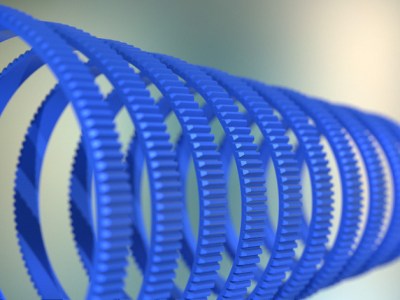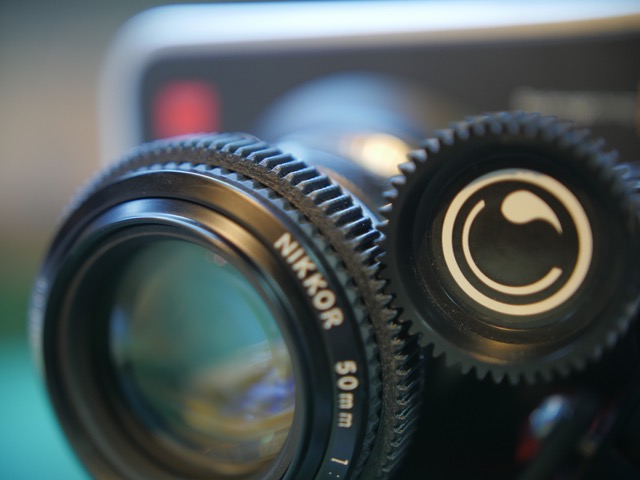Key Grip, Gaffer, Best Boy – any of us who’ve sat through every last minute of a Marvel movie to get to the post-credits scene – mmm, schawarma! – have seen the obscure titles of folks involved in movie making. But “Focus Puller”? How hard can it be to focus a camera?
Turns out there’s a lot to the job, and in a many cases it makes sense to mechanize the task. Pro cinematic cameras have geared rings for just that reason, and now your DSLR lens can have them too with customized, 3D printed follow-focus gears.
 Unwilling to permanently modify his DSLR camera lens and dissatisfied with after-market lens gearing solutions, [Jaymis Loveday] learned enough OpenSCAD to generate gears from 50mm to 100mm in diameter in 0.5mm increments for a snug friction fit. Teamed up with commercially available focus pulling equipment, these lens gears should really help [Jaymis] get professional results from consumer lenses.
Unwilling to permanently modify his DSLR camera lens and dissatisfied with after-market lens gearing solutions, [Jaymis Loveday] learned enough OpenSCAD to generate gears from 50mm to 100mm in diameter in 0.5mm increments for a snug friction fit. Teamed up with commercially available focus pulling equipment, these lens gears should really help [Jaymis] get professional results from consumer lenses.
Unfortunately, [Jaymis] doesn’t include any video of the gears in action, but the demo footage shown below presumably has some shots that were enabled by his custom gears. And even if it doesn’t, there are some really cool shots in it worth watching.
And for the budding cinematographers out there without access to a 3D printer, there’s always this hardware store solution to focus pulling.
















That was a frickin’ awesome demo reel, it made my head explode.
Sadly he doesn’t understand copyright. That song he does not have the rights to use freely. Imagine Dragons does not freely give everyone commercial use of their music. That song is considered a platinum song and has very high licensing for a video that goes online for all to see and for someone to sell with. from their licensing holder, ” Platinum songs may be available for commercial license upon request and will start at $50,000 (USD)”
Stealing someone else’s work to advertise your own is not cool.
how do you know he didn’t acquire the rights?
Timgray is making an educated guess. It is extremely unlikely Jaymis acquired the rights to this song. That said, if Jaymis has no intention of commercializing this project, it is possible his use of the song would be covered by the fair use exemption. Jaymis lives in Australia so his use of this song could be totally legal, or super illegal. I have no idea how Australian copy right law works. Unless timgray1 is a practicing Australian copy right lawyer, we can probably just ignore him.
Exactly. Perhaps Jaymis gave Imagine Dragons a freebie, allowing them the priviledge of having their song playing as background music during his awesome platinum video production :)
I didn’t watch the video, but too often music or other background noise detracts from the experience. I watched a YouTube video a couple weeks ago about small engine carburetors, and country music station in the background ruined it for me.
I just tore down and rebuilt my Stihl weedeater. Now its gruntier than ever and I repaired the throttle cable with free stuff to hand. Thanks youtube.
@timgray1
noooo oneeeee careeeeees
It’s not theft it’s copyright infringement. That said, who cares? He’s not selling anything using the song.
Sounds like uninspired flat background noise to me, not sure you didn’t mean to say $50.00.
The good thing is his demo reel is higher quality work than anything imagine dragons will ever produce.
It’s a simple solution to the problem, but i feel that it’d be cheaper and easier to patch into the existing autofocus motor.
Using focus gears is very common. I must have modified a hundred lenses with focus gears at Laika when I worked there. We used completely manual lenses, all Nikons on Canon bodies so there is no focus motors in them. For the stop motion stuff we did electronically controlled lenses are bad news, the aperture motor does not return to the exact spot every time the camera is fired so you get a flickering effect in the final product.
A little google search tells me you were in Laika’s moco department macona? Congratulations on all the wonderful work! Big inspiration to me, one of my main areas of nerding is motion control.
Yeah, I did some contract work on Coraline and then was hired on for most of Paranorman.
Sadly, the autofocus motors aren’t reliable and don’t let you move to a set position – it’s an open loop system, unless you’re reading focus through the lens, which you can’t while shooting video. They’re also much slower to use via the API than while autofocusing via the camera.
This is the case on canon, at least using the standard interfaces. I’m not aware of any firmware mods which change this.
Which is why they make this thing called a “video camera”, which is specifically designed and made to focus even when recording video :P
Can’t be too surprised that using a tool in a way it was not meant to be used results in poor performance in some key aspects.
Using a closed loop independent servo system for the lens would make it far more expensive, and since the pricetag is usually the reason people use DLSRs for video instead of a true video camera…
When you go beyond “video camera” into “cinema camera”, there is no such thing as auto-focus. High-end video/cinema lenses are manual focus (and iris).
The gearing allows smooth (or abrupt) focus pulls between subjects, using a “follow focus”, which may be a relatively simple gearing system attached to the camera, or a wireless rig so the focus puller can be somewhere else.
Good thought except that a lot of indie filmmakers are using old manual camera lenses that don’t Autofocus. I myself have a ton of old all metal manual Nikkor lenses that work great. Man of the old M42 count lenses were universal and didn’t have a stop down diaphragm or click indents for aperture settings as well. These will easily mount to the Canon systems and allows for stepless aperture settings. Many time, people will modify the click stop lenses for stepless operation as well.
Since you are doing video, you have a live feed streaming, so judging focus and exposure is pretty easy without things like AF and autoexposure, especially if you are shooting at a fixed ISO and shutterspeed.
Additioanlly, this is how cinematography has traditionally been done. The camera operator focus their attention on the framing of the shot and the follow focus/focus puller has one job: Focus and refocus on the appropriate elements in the scene. Both jobs were too important to leave to one person in the film days where you couldn’t really crop and poor focus wouldn’t be found until the dailies were developed (assuming 1st unit. 2nd unit in a remote location may have a longer wait to find out if a re-shoot is needed).
That said, if someone would let you have direct access to I/O on the AF system, you could do things like digital follow focus or even jumping to pre-determined spots via a uC.
Wow – that guy has made a whole bunch of really cool things!
Way cool!
Thanks for the comments everyone. Yes, basically all of the non-animated shots in the reel were filmed using a follow-focus rig in some way. Around half used cinema lenses with integrated gearing, and the rest using DSLR lenses with 3D printed gears.
Probably the most interesting/relevant for Hackaday readers is the piece with the 3 overlaid copies of the singer (at 0:08). That was using robotic motion-control to focus and move the camera on a crane, repeating the same shot over and over, which allowed the appearing/disappearing effect. Here’s the full piece: http://jaymis.com/2013/09/little-scout-march-over-to-me-music-video/
Can you get this quality with an under $1K printer?
Not sure, but I bet you can buy the gears ready-made on chinese sites for a buck or so, if that’s what you need.
sure you can!
Yes! These were all printed on a Printrbot Simple Metal, which is US$600. They work well in either PLA or ABS plastic.
This is cheap for 3d printer
Brisbane Powerhouse in the last shot. Awesome! Is this guy an Aussie?
Looks like he is! Fantastic